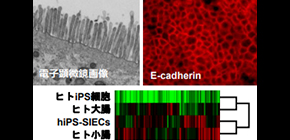
Small intestinal epithelial cells generated from human iPS cells
Will be applied to drug absorption and metabolism studies
A group of researchers led by Professor Hiroyuki MIZUGUCHI and Assistant Professor Kazuo TAKAYAMA generated small intestinal epithelial-like cells from human-induced pluripotent stem cells (hiPS-SIECs). These cells have properties of small intestinal epithelial-like cells (SIECs), not colonic epithelial-like cells (ELCs), and exert SIEC molecular functions to play a critical role in drug absorption and metabolism.
Drugs administered orally (e.g., through tablets and capsules) are absorbed and metabolized in the small intestines, metabolized by the liver, and then transported through the body, so evaluating absorption and metabolism of drug candidates in the small intestines is important in drug development.
Obtaining and culturing human-derived epithelial-like cells is difficult, so absorption and metabolism of drug candidates is evaluated by using cancer cell lines and laboratory animals such as mice. However, because of low drug metabolism of cancer cell lines and the species difference between mice and humans, it is difficult to predict the precise absorption and metabolism of oral drugs in evaluation systems using cancer lines. Thus, researchers tried to generate intestinal epithelial cells from human iPS cells for use in drug absorption and metabolism studies, but no one succeeded in generating small intestinal epithelial-like cells.
By referring to the developmental process of the small intestine, this group performed a screen for growth factors and compounds for promoting differentiation of SIECs from human iPS cells, generating SIECs at high efficiency (90 percent or higher). In addition, they confirmed that the hiPS-SIECs had (1) not small intestinal properties but colonic properties, (2) the microvillus structure that is seen in living small intestines, and (3) a molecular function that plays an important role in drug absorption and metabolism.
This group’s achievements allow for more accurate and easier evaluation of absorption and metabolism of drug candidates. By using iPS cells from several individuals, it will become possible to perform drug absorption and metabolism studies in consideration of individual differences. The hiPS-SIECs will be used as a drug development tool capable of performing precise evaluation of drug absorption and metabolism.
Abstract
The small intestine plays an important role in the absorption and metabolism of oral drugs. In the current evaluation system, it is difficult to predict the precise absorption and metabolism of oral drugs. In this study, we generated small intestinal epithelial-like cells from human induced pluripotent stem cells (hiPS-SIECs), which could be applied to drug absorption and metabolism studies. The small intestinal epithelial-like cells were efficiently generated from human induced pluripotent stem cell by treatment with WNT3A, R-spondin 3, Noggin, EGF, IGF-1, SB202190, and dexamethasone. The gene expression levels of small intestinal epithelial cell (SIEC) markers were similar between the hiPS-SIECs and human adult small intestine. Importantly, the gene expression levels of colonic epithelial cell markers in the hiPS-SIECs were much lower than those in human adult colon. The hiPS-SIECs generated by our protocol exerted various SIEC functions. In conclusion, the hiPS-SIECs can be utilized for evaluation of drug absorption and metabolism.

[Differentiation] We found that the small intestinal epithelial-like cells were efficiently generated from human iPS cells by treatment with WNT3A, R-spondin 3, Noggin, EGF (epithelial growth factor), IGF-1 (insulin-like growth factor 1), SB202190 and dexamethasone. [Characterization] We observed the microvillus of monolayer of the human iPS cell-derived small intestinal epithelial-like cells using an electron microscope. Immunohistochemical analysis showed that the human iPS cell-derived small intestinal epithelial-like cells were positive for E-cadherin. The intestinal-focused gene expression profile in human iPS cell-derived small intestinal epithelial-like cells was similar to that of Small Intestine rather than that of Colon. [Application] The human iPS cell-derived small intestinal epithelial-like cells would be applicable for drug absorption and metabolism studies (e.g. PEPT1 transporter assay, CYP3A4 (cytochrome P450 family 3 subfamily A member 4) induction test and CES2 (carboxylesterase 2)-mediated drug metabolism test).
The article, “Microstructural properties of the vertical occipital fasciculus explain the variability in human stereoacuity” was published in PNAS at DOI: https://doi.org/10.1016/j.stemcr.2018.10.019
Related links
